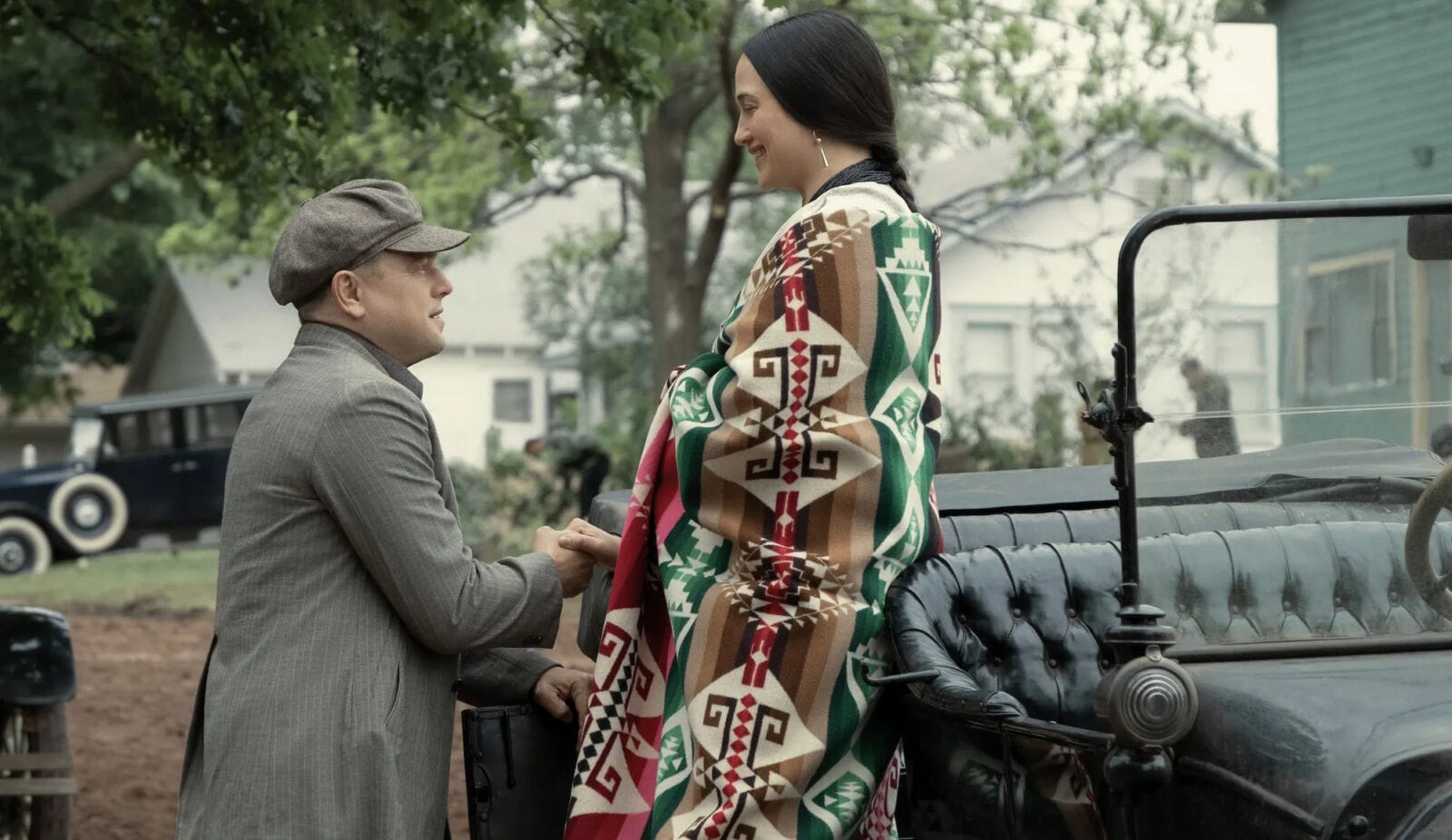The first of many to die in Killers of the Flower Moon is seen dying from above. He’s an Osage Native American, poisoned, writhing on the floor and foaming at the mouth, the camera watching from above like a bystander god. Martin Scorsese, the film’s director, is no stranger to staring at death (or to overhead shots, or to staring at death from an overhead shot), but this feels lonelier than the images he’s evoking: a member of a tribe dying alone on the floor, the lens of our hindsight watching just out of reach. It’s violent—but it’s nothing compared to the history it’s remembering.
READ ALSO: Read all of Ryan Bordow’s movie reviews here
The film tells the true story of the Osage Reign of Terror, a series of murders wrought by a cabal of wealthy whites to steal money and land from their native Osage neighbors. Osage land was rich with oil in the early twentieth century, so white Americans, naturally, began circling it like hawks, scheming their way in through insurance fraud, political coercion, and parasitic relationships with the Osage people. Local businessman William Hale (played here by Robert De Niro) was an especially pernicious leech: among other schemes, he married his nephew Ernest into a well-off Osage family so he could inherit the family’s land rights as they “mysteriously died.” This went on for years before his arrest by the FBI.
The conspiracy is covered in detail by the book the film is based on, David Grann’s Killers of the Flower Moon: The Osage Murders and the Birth of the FBI. The film’s original script centered the latter half of that title—the FBI solving the case in a historical crime procedural—but, according to Scorsese, the creative team later chose to center the Osage instead, rewriting the script to follow William’s nephew Ernest (Leonardo DiCaprio) and the family he married into. That refocus grounds much of the film.
It also reshapes the usual Scorsese-isms: slow motion, propulsive music, voiceover, all tinged with the soul of the reservation. In Killers’ opening minutes, the Osage dance in slow motion around a geyser of oil as the score blends Native drums and electric guitars, marrying the styles at play with flair and mood to spare. It’s beautiful, spiritual, foreboding. And Scorsese’s wide-angled worldbuilding is gorgeously unobtrusive, so smoothly shot and respectful of the setting—when an amateur uses a drone shot, I mostly think about drones; when Scorsese uses a crane shot, soaring over the oilfields and flowers, I think about the Osage, their land and their lives; the camera moves too fluidly to call attention to itself. It’s the work of a master.
When the voiceover kicks in, it’s the voice of Mollie Kyle, the woman whose family was targeted by William Hale. She lists the names of recently murdered Osage, and then we see her eyes—disquieted concern and the fire of righteous anger, the first of many tells of a powerhouse performance. Mollie is played by the revelatory Lily Gladstone, who carries tremendous depths of love, suffering, and loss; it’s the kind of career-making performance that proves her career should’ve been made years ago. De Niro and DiCaprio’s villainy may have the lion’s share of screen time—a natural and self-critical move for a white male filmmaker, though it can play at odds with the renewed focus on the Osage—but Gladstone is the story’s anchor, pulling us down to the bedrock of her despair.
Her spiral accelerates when she meets Ernest Burkhart, but it’s not all grim at first. The film feels out their budding romance even as motives dance in the ulterior— “coyote wants money,” Mollie teases Ernest, and Ernest isn’t coy about that particular fact. But there’s still something between them. The edit builds their connection with subtle shifts towards the inevitable: Thelma Schoonmaker, Scorsese’s legendary longtime editor, once said Scorsese’s movies “aren’t violent until I’ve edited them,” and in Killers she could claim the relational tension as well. She has a penchant for dropping non-chronological vignettes into otherwise timebound scenes, recontextualizing moments even as they play out. What that means for Mollie and Ernest is perpetually shaky ground: each minute of romance is a cut or two away from the evil rumbling beneath.
It’s a frog in boiling water feeling, evenly paced and gradually heating until Mollie wakes up one day and the evil is in her home, covered in her family’s blood. That the film evokes Mollie’s dread while spending more time with Ernest can feel a bit frictional, but Ernest’s character breeds an important disgust—disgust with the greed and racialized hatred behind the foul acts of violence Scorsese shows so bluntly. The film gets to the moral filth of genocide through Ernest’s decaying soul. Some of its musings on racialized violence can feel obvious or rudimentary—it parallels the Osage murders with the Tulsa Race Massacre by showing a newsreel about the Massacre and having someone say “it’s just like Tulsa” twice in a row—but for the most part, this is an essential American document of one of America’s greatest shames, localized in the particulars of an undertold story.
And true to Scorsese’s raison d’être, there are grace notes rising above it all. The director is in his 80s now, talking about death in the trades, and his late-period output—chiefly Silence and The Irishman—gives the impression of a man making peace with God. That spiritual dimension is not lost on Killers. It features one of the most hopeful, peaceful, and kind scenes of the afterlife in cinematic memory, one of the most potent images of Scorsese’s oeuvre, with the delicate transcendence of his Catholic work but clothed in a culture not his. And it doesn’t feel appropriative: as Scorsese acknowledges in a poignant final flourish too moving to describe here, he’s at the end of the day on the outside looking in—but looking in with respect and empathy. Or perhaps looking down, part of his soul already leaving, capturing a final overhead shot as he goes. Killers of the Flower Moon ends on one of those shots, and it’s determined to center the Osage even as it drifts away.
★★★★½ (4.5/5)




